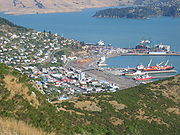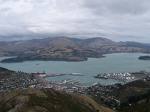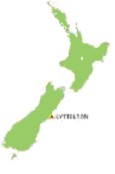
Lyttelton (43°36′00″S 172°43′00″E / -43.6, 172.7167) is a port town on the north shore of Lyttelton Harbour next to Banks Peninsula, 12 km by road from Christchurch on the eastern coast of the South Island of New Zealand. According to the 2001 census, the usually-resident population of Lyttelton (including neighbouring bays such as Rapaki and Corsair Bay) was 3,042.
The town is linked to Christchurch by railway and road tunnels through the Port Hills. At 1.9 km long, the Lyttelton Road Tunnel (opened in 1964) is the country's longest road tunnel; and the railway tunnel of the Main South Line, officially opened on 1867-12-09, is the country's oldest.

The harbour is an inlet on the north-western side of Banks Peninsula, extending 18 km inland from the southern end of Pegasus Bay. It is surrounded by steep hills formed from the sides of an extinct volcanic crater, which rise to a height of 500 m. Several smaller settlements are dotted along the shore of the harbour, notably Governors Bay and Diamond Harbour. A small island, Quail Island, sits in the upper harbour south-west of Lyttelton.
A home for Māori for about 700 years, Lyttelton, or Te whaka raupo was discovered by European settlers on 16 February 1770 during the Endeavour's first voyage to New Zealand. The earliest evidence of a human presence in the area are moa bones dating from approx 1250.
In August 1849 it was officially proclaimed a port.
Lyttelton was formerly called Port Cooper and Port Victoria. It was the original settlement in the district (1850). The name Lyttelton was given to it in honour of George William Lyttelton of the Canterbury Association, which had led the colonisation of the area.
The Lyttelton Times was one of the principal newspapers of the Canterbury region for 80 years, published from 1851 until 1929, at which time it became the Christchurch Times, until publication ceased in 1935.
Aiming to establish a Church of England colony in New Zealand, the Canterbury Association was founded in 1850. As Lyttelton was a harbour, and had a large amount of flat land suitable for farming and development nearby, it was ideal for a colony.

In 1862 the first telegraph transmission in New Zealand was made from Lyttelton Post Office.
In 1870 fire destroyed all the wooden buildings in Norwich Quay, on the main street of Lyttelton.
On January 1, 1908, the Nimrod Expedition, headed by Ernest Shackleton to explore Antarctica left from the harbour here.
The Lyttelton Harbour Board was created in 1877 to be in charge of the harbour's management. It was dissolved in 1989 after the passing of the 1988 Port Companies Act, which forced it to split into two separate organizations, one commercial (the Lyttelton Port Company, currently owned by Christchurch City Holdings, the commercial arm of the city council) and one non-commercial.
In 1996 the Lyttelton Port Company registered on the New Zealand Stock Exchange.
One of the features of Lyttelton is the Timeball station. The Lyttelton Timeball Station was erected in 1876 and is one of only five remaining timeball stations in working order in the world. The castle-like building is located high on a ridge above the port with extensive views over the harbour. It is now operated as a museum by the Historic Places Trust and is open for visitors from 10:00am-5:30pm daily.
On 19 November 2005, it was announced that 60% of the Banks Peninsula District ratepayers voted to amalgamate with the neighbouring Christchurch City Council, which took place on 6 March 2006.
Pilgrim's Rock shows the place that European settlers first set foot in the harbour. The location of the rock is well inland from the sea, because much of Lyttelton's land has been reclaimed from the ocean since the Pilgrims arrived.
The Holy Trinity Church, the oldest stone church in Canterbury, was built out of stone transported from Quail Island on land intended for the Cathedral of the Diocese.
Lyttelton was the location for most of the exterior scenes in Peter Jackson's 1996 horror movie The Frighteners
|



